The Complete (and Expansive) Guide to Monk Mode
In modern-day society, the average human finds themselves pushed around like a ragdoll by various stimuli.
In this environment, you can get trapped in the status games of social media, spend hours browsing erotic content online, or stuff your face with empty-calorie foods.
If those don’t suit your fancy, you can get lost in one of the many hyper-realistic video games worlds or an endless loop of streaming video.
Paradoxically, even in the midst of all this distraction, there is more opportunity than ever existed at any given time.
However, many people are mentally ill-equipped to grasp these opportunities because they lack the lucidity to take advantage of them.
Enter monk mode, a solution to help the individual craft his mental landscape to be a more effective person in this opportunity-rich environment.
This article is going to be giving a complete overview of monk mode, how you can use it to pierce through the illusions of life, and eventually attain whatever goals or objectives you desire.
What is Monk Mode?
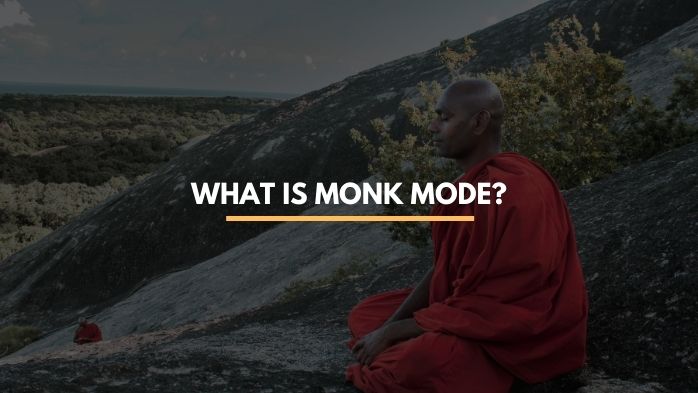
“There is only one perpetrator of evil on the planet: human unconsciousness. That realization is true forgiveness. With forgiveness, your victim identity dissolves, and your true power emerges–the power of Presence. Instead of blaming the darkness, you bring in the light.” – Eckhart Tolle, A New Earth
Monk mode is a focused lifestyle or where a person temporarily cuts out distractions such as social media, entertainment, or non-essential commitments in order to pursue a specific goal with intense discipline and clarity. Inspired by the minimalist lifestyle of monks, it emphasizes deep work, self-discipline, and personal growth. It is often used to help break bad habits, build routines, or accelerate success.
Looking at the modern world as it is right now, it’s obvious that the inherent dysfunction of humanity has not only threatened relationships on an individual level but the survival of the planet at large.
The human mind has always had corners of darkness, however, technology has amplified and exposed this dysfunction to a significant degree – as many people use technology completely irresponsibly.
Unfortunately, there’s a price that the individual pays due to this behavior.
Magnified on a macro scale, you have millions of people who are unable to skillfully navigate our external world.
They lack the socialization necessary to use the many things in modern society rather than be used by them.
Monk mode is one way (out of many) to start the process towards this socialization. It is the ultimate in mind management.
My Own Experiences In Monk Mode
In 2011, I found myself requiring space and distance away from various circumstances in my life. I was in college at the time and as my sophomore year was ending, I decided to move off campus and isolate myself in order to probe the depths of my mind.
There was no name for “monk mode” at this time but this is something I instinctively realized I needed to do.
During this period, my life was pretty monochrome and simple. School, work-study, come home, homework, meditation, light workout, journaling and contemplation, repeat.
During this period, I had the mental oxygen to ask introspective questions of myself and try and plot of course where I wanted my life to be headed. The questions I explored here would shape the next 2 years of my college existence and shortly post-college.
I engaged in this way of living and being as a sort of “hard reset”. It lasted 6 months. And guess what? It worked.
I came out of that period of cloistering as a refreshed and renewed version of myself.
In the podcast episode below, I give a deeper insight of my experiences during it and more fruits of the practice that I’m not sharing here.
The Monk Mode Basics
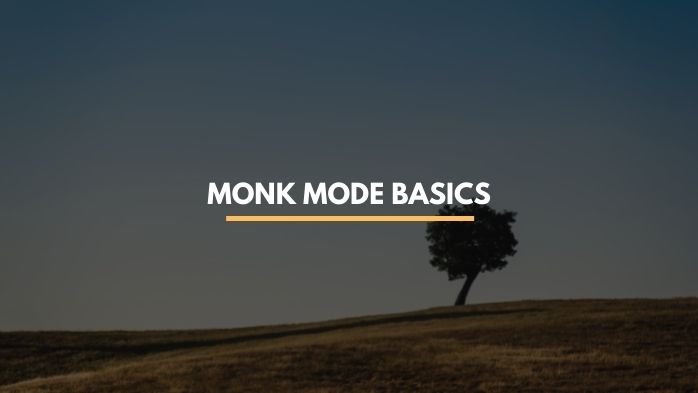
Monk mode is intended to take one’s attention (which is normally outwardly focused) and direct it inward, in the attempt to develop high levels of mental clarity and productivity.
With this interior focus, it becomes easy to identify patterns of compulsion or mindlessness; things which go undetected in the turbulence of normal life.
This is the intention of actual monks and contemplatives who cloister themselves in monasteries for years at a time.
We’ll be taking this practice of introspection and applying it to our daily lives.
Generally, monk mode is concerned with five main objectives:
- Enhancing equanimity
- Increasing output and productivity
- Magnifying self-awareness
- Reducing mental instability
- Creating a foundation for self-sustaining good habits
Taken as a whole, this sharpens the discursive mind and turn someone into a weapon that can slice through life with discernment instead of the normal dullness of reactivity and unconsciousness.
In my worldview, there’s three “types” of monk mode:
- Complete Isolation – In this mode, you withdraw from society and become a virtual recluse. This is almost impossible to do without living in the sticks or a monastery of some kind. If you’re reading this, I have a feeling that you don’t want to become a monk, rather you just want the benefits a “monastic” lifestyle involves.
- Rhythmic – This involves periods of near or completely-near isolation from activities that provoke massive amounts of stimulation or do not move one ahead in life.
- Engaged Selectivity – This is someone who selectively engages with various objects and conventions in the world and chooses to forgo them entirely or practice shrewdness in relationship to them.
Most people will find the Rhythmic or Engaged Selectivity parts to be more of their liking and these are the types that I explore in this article.
How to (Properly) Do Monk Mode
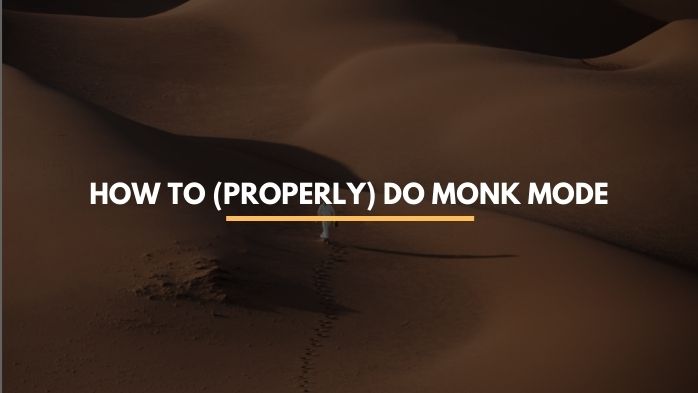
This is the first phase of the expansion of awareness…learning to scrutinize, learning to observe without commenting on what is happening within us instead of being dragged back into the inner chatter that serves as the cloth for the fashionable outfit of a new identity.“ – Martin Laird, A Sunlit Absence
At this point, it should be quite obvious that monk mode is an intentional way of living. As such, there’s certain things you should vs. shouldn’t engage in.
Everyone’s life and circumstances are different. There’s some things that some people can avoid, where other people cannot.
For example: if you’re in a relationship of some kind, your partner’s going to be pretty pissed at you if you don’t have any intimacy.
Likewise, if your job involves sales, then it’s pretty much impossible to socially withdraw.
However, there are some things you should absolutely be involved in during this time and other things you should absolutely not.
The ones in bold are absolutely mandatory on the monk mode journey. If you’re going to follow any form of monk mode, make sure you do not break these.
Note: This is not an exhaustive list. There are gradations to introspection, this is just a large and general overview.
Refrain From:
- Social media use – Max 30. mins per day on ALL platforms
- Purposeless Internet browsing
- Junk food and empty calorie food – Sugars, sweets, salty foods
- Sexual gratification of any kind – Complete abstinence if possible
- Alcohol, drugs, or other intoxicants
- Intermittent checking of smartphones – In line, when bored, etc.
- Needless conversation for the sake of conversation
Engage In:
- Meditation/mindfulness* – At least 30 minutes/day
- Reading books
- Getting into good physical shape – Cardio, strength training, etc.
- Purposeful and selective isolation** – Conscious withdrawal from social obligations
- Spending deep work sessions on important projects
- Skill-based learning intended to increase standing in life
- Completing backlogged tasks that were constantly pushed to “tomorrow”
The bolded under “refrain from” are those that you absolutely want to stay away from during this period. When you re-engage to a normal mode of life, you will want to limit your involvement with these.
The bolded under “engage in” will help the mind to return to a more focused and self-referential state.
You’ll want to keep a journal. This will allow you to observe your day-to-day feelings and moods in addition to noting any changes you witness in your internal and outward disposition.
* Meditation/mindfulness is an essential part of monk mode. Meditation is a way to enter the silence of your person and transcend thoughts and feelings, allowing you access to a deeper presence (God).
** Depending on your flavor of monk mode, you’ll want to scale back your nonessential interactions with friends, family, and acquaintances. You should tell your friends and family members that you’re doing this monk mode challenge and they’ll have more knowledge as to why you don’t seem as up for certain social interactions. Let them know this is only temporary and you plan on getting back into the swing of things after this period is over.
How to Institute Monk Mode Practices
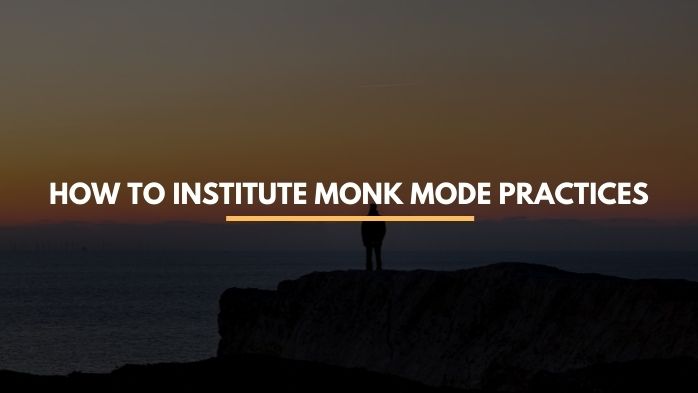
Length of Time:
You decide how long you want to be in a state of monk mode.
The best results are seen when instituted for a minimum of 1-3 months.
Choose Your Depth:
In monk mode, relative social isolation is common.
When you tone down on the amount of idle conversations you have, the amount of times you visit social media in a day (or week), and even choose to stay in and work on a project vs. going out – your social world is going to contract. It’s supposed to be that way.
If you are someone who has a lot of social engagements in real life or online, becoming a relative recluse for more than a month will most likely be difficult, so you’ll have to compensate in other ways.
Going out with friends and being social may mean no Internet in your home or no Netflix. If you want the maximum benefits, you’re going to have to get comfortable with being with yourself and your thoughts.
The degree of social involvement is negotiable. Digging to the core of your inner self is not.
Think About Yourself In Relation to “Normal Things”
Monk mode purposefully removes stimulating and mindless activities for a period of time in order to establish a more self-aware relationship with them.
Things that people consider “normal” activities in modern-day society are things that monk mode takes a scrutinizing eye towards.
Drinking, sexual pleasure, social media, and idle chatter are all things (among others) that have a high threshold for compulsion. These things often offer instant ways to feel good and avoid deeper plumbing into thoughts and feelings.
Even as you return to a more normal rhythm of life, you’ll want to stay away from things that offer instant gratification with little upfront investment.
A Way to Think About Monk Mode
A good framework for implementing monk mode (or any other behavioral change) is James Clear’s Atomic Habits.
In it, he states rules for a good habit to be implemented and for a bad habit to be removed.
Good habits must be:
- Obvious
- Attractive
- Easy
- Satisfying
Bad habits must be:
- Invisible
- Unattractive
- Difficult
- Unsatisfying
If you want to spend less or even no time on social media, put a filter on your computer and remove the apps from your phone. This keeps it out of sight, out of mind, and most importantly – inaccessible.
If you want to meditate more, start with 5 minutes at the end of the day, then build upon it. This makes it easy to do, pleasurable, and satisfying when you hit that goal.
If you want to eat less junk food, throw away all the junk you have in your closet and fridge. Go out and buy healthy food.
You want to increase the friction between detrimental behaviors and reduce the space between beneficial behaviors.
Is it a cure all? No. But it doesn’t take a scientist to know that if you don’t have a barrier between you and the activity in question, it will take little to no conscious effort to engage in it. With these stopgap measures, you at least have a chance to act mindfully.
You’ll also want to keep in mind the “cardinal rule of behavior change” as well.
What is immediately rewarded is repeated. What is immediately punished is avoided. – James Clear, Atomic Habits
When you immediately reward yourself after a beneficial behavior, you make it likely to happen again.
When you immediately punish yourself after a detrimental behavior, you decrease the chance it will happen again.
Humans like immediate feedback. This is using your biology for you rather than against you.
Likewise, environment design can greatly help with monk mode.
Adopting practices of minimalism will help you intentionally design your environment. This can make it easier to do the right thing than the wrong thing.
The Monk Mode Schedule
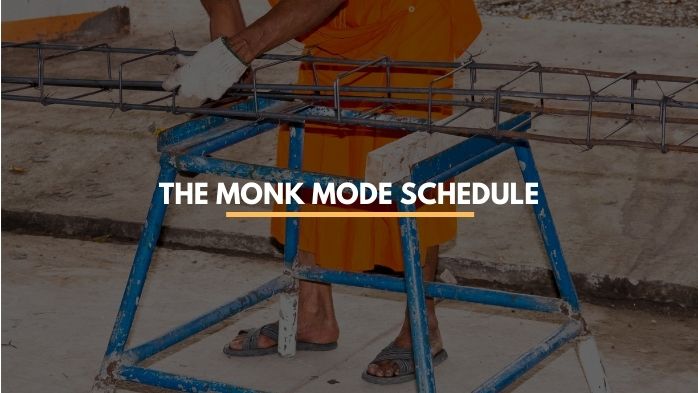
Many guys ask:
What should my daily routine and schedule look like during monk mode?
Well, your daily schedule should be anything that helps you get closer to achieving:
- Inner peace
- A specific goal you have
- Reduction of compulsive behaviors
Your schedule in monk mode may look very dry and barren from the outside, but this is where you “fill in the blanks” with your own inner meaning.
When I was deeply engaged in monk mode several years ago, my schedule was very dry and straight-cut.
If you want more info on how to structure/schedule monk mode, check out the article Why You Need a Schedule During Monk Mode.
Troubles that (May) Arise During Monk Mode
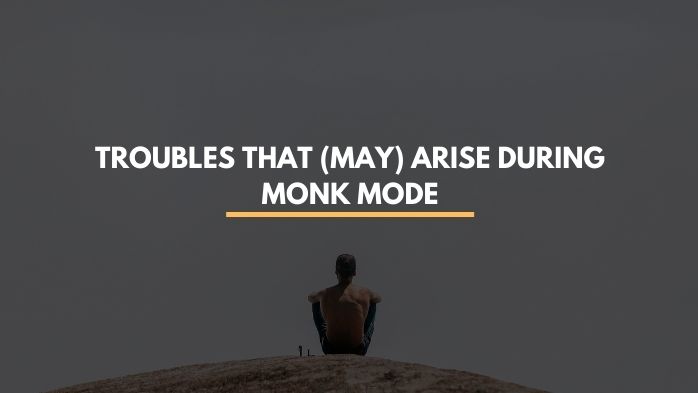
When I did my first monk mode challenge, I encountered various unforeseen obstacles. I soon learned that variations of these are very common.
Here’s some of the most common ones are how to overcome them.
Mental and physical craving
Mental and physical agitation will become evident for most people who go on monk mode.
Part of this is physical. The modern world has shifted our ordinary baseline for stimulation that the body literally begins craving high levels of it.
The other part is mental. During periods of relative silence, ordinarily background mental chatter becomes evident in the absence of distraction.
Part of the practice of meditation is to realize that you are not your thoughts, feelings, or emotions, which means you are not this craving.
Monk mode, if done properly will help you experience this. The only solution is to ride out these feelings of craving until they subside.
If and when you do resist the urge to check social media or to watch TV for hours, part of you “levels up”.
You become mentally tougher.
Projection and rumination
When the mind that is untrained in stillness is not occupied with stimulating activities, it starts to create mental loops.
These mental loops may involve replaying past events, fantasizing, or projection of future events or thoughts/intentions from other people.
It is easy to become bored when you’re reading a book or meditating when exerting mental effort is foreign to you. Again, you will experience the urge to go watch YouTube or engage in some other digital stimulation.
This is one of those things that you’ll need to push through, especially in the first month or so as your new baseline becomes established.
“Blue Moods” and slight pessimism
Many things in our modern world are “temporary state boosters”. I call these “red herrings”.
By that, I mean, there’s a lot of things in our world to remind us of the fact that human existence is “nasty, brutish, and short”.
Anyone can take a substance or watch a movie or watch porn and just escape from life…for a little while. Until the problems come back again and sometimes in greater number.
Monk mode exposes the true nature of your life without these “state boosters”. You may find that your overall day-to-day disposition drops from a 6/10 to a 3/10. You may even have panic attacks or become incredibly depressed because you realize that your life sucks and that work needs to be done.
A Word on Addiction
The word “addiction” is overused in modern parlance.
However, this definition of addiction is one given by Mentalhelp.net and is one everyone can agree on:
Addiction is the repeated involvement with a substance or activity, despite the substantial harm it now causes, because that involvement was (and may continue to be) pleasurable and/or valuable.
Monk mode will expose addictions or bad habits on the borderline of addiction.
However, the treatment of addiction is beyond monk mode.
Monk mode is not a magic pill that can be used in place of a trained mental health professional.
I would encourage you to seek professional help if you struggle with addiction.
The Benefits of Monk Mode
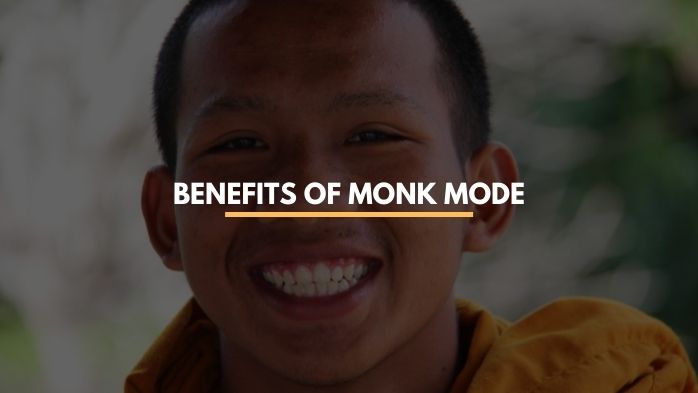
The benefits I personally saw when I did my initial version of monk mode were:
- Increased mental clarity
- Greater discernment
- More focus
- More confidence
- Less attraction to “quick hit” stimulation
- Greater empathy towards people
- Enhanced desire for social interactions
Conclusion + Wrapping Up
If your life is overcrowded with “obligations”, compulsions, and mental clutter, monk mode is for you. It will allow you to separate illusion from reality and focus on what’s really important in the time you have alive.
- Monk mode is a practice to create inner stillness, increase mental discernment, and become more productive.
- It can be done for any varying length of time, but the best results happen after 1 month.
- The biggest issues in the beginning will be mental agitation but you need to push through it.
- You want to make monk mode as attractive as possible by focusing on the benefits of the challenge.
- This practice will expose flaws in your current lifestyle and possible solutions to these flaws.
Monk mode is one way to start towards the path towards a fulfilling and sustainable lifestyle. But it’s not the end. Not even close.
In order to continue along the path, you need a blueprint. And that’s exactly what I’ve created in my course, Cornerstone.
Cornerstone is designed to help you build a stable and strong foundation in 4 different aspects of your personal development:
- Your psychology
- Your philosophy
- Your productivity
- Your progression
By doing this, you will have a great shot at creating a happy, fulfilling, and successful life for yourself.
If you want more info on the course, check out the link below.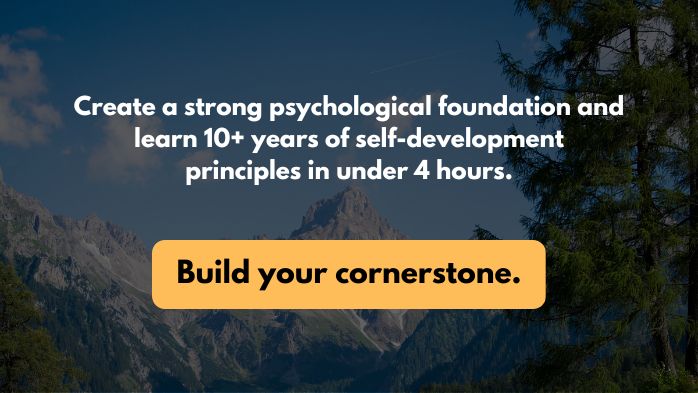
Explore Monk Mode Deeper:
Frequently Asked Questions About Monk Mode
1. What does going into monk mode mean?
Going into monk mode means intentionally cutting out distractions like social media, partying, or time-wasting habits to focus on self-improvement goals such as fitness, business, study, or mental clarity.
2. How do you activate monk mode?
To activate monk mode, define your goal, create a distraction-free environment, set a strict routine, and commit to consistent discipline—often including habits like early rising, meditation, deep work, and digital detox.
3. How long should monk mode last?
There’s no set time, I recommend a minimum of 1 to 3 months. Some people go longer depending on the intensity of their goals or the results they want.
4. Is monk mode effective for productivity?
Yes. Monk mode boosts productivity by eliminating distractions and sharpening focus. It encourages deep work, habit building, and momentum, making it ideal for people with big goals or tight deadlines.
5. Can you use monk mode to advance in fitness or business?
Yes. Monk mode is perfect for this. Many use monk mode to train intensely, follow strict diets, build side hustles, or launch businesses—because the structure helps maintain laser focus and self-discipline.
6. What are monk mode rules or principles?
While flexible, core monk mode rules usually include:
- No social media or entertainment
- Wake up early
- Exercise daily
- Journaling and/or meditation
- Focused work sessions
- No unnecessary outings or distractions
7. Is monk mode realistic for everyone?
Not everyone needs to do monk mode, nor should everyone do monk mode. It can be customized for any lifestyle, but it requires strong commitment. Even part-time or “light” monk mode (like weekends or mornings only) can deliver noticeable benefits.
8. Does monk mode mean no fun or social life?
It depends on how far you want to take it. You don’t have to cut social life out entirely, but you should deviate away from any social obligations which include extreme stimulation (such as partying or recreational drug use) until the period of time is over.

Hii, my name is Thauã , 17 years and I am Brazilian. I’ve just met you right now and I loved this content and what you are trying to do, thank you so much! If you let me talk, can I talk a little about me? I don’t know if you really can read this, but anyway, it’ll be good for me. I’ve been trying to do Monk Mode so many times and I couldn’t get that. I started just with NoFap ( you know, of course ) and in the beginning was terrible.. I even couldn’t get a 7 days strike and for a long time I’ve been there. After knowing Monk Mode my best strike was of 33 days. I was feeling so good, so powerful and awareness but after that my life-mental-health fell again. I have a lot of goals in my life and it is what drives me to go forward, training Monk Mode and these good habits. I know what I have to do and where I want to arrive. So.. Why is that so difficult? Can I have a disease? This addiction is terribly powerful. I’m going to follow you, to practice with you, I’m going to try, and finally… Can I win? It depends upon me, right? I’m having so much thoughts right now and I’m kind of don’t know what to write but this is good. I would like to talk to someone, to express myself, my thoughts, my goals and all… Sorry for that, I may not have been so clear, my apologies for that lol. Again.. Thank you!
Hey Thauã,
Thanks for the detailed response. Monk mode is not a walk in the park and takes some serious commitment. Good on you for trying, though.
If you want to connect further, just sign up for the email list. It’s the best way to keep in touch with things I send out time to time.
I avoided sweets but occasionally can we use jaggery or honey
I did my first monk mode in the beginning of last year to sort out mess in my life. It worked well and I completed 90 days which was my original schedule. Post that I realized that my life was much disciplined and I built some habits which I could sustain, I went back to social life and occasional indulgence as well which works well to keep the balance. I still go in monk mode once a week every quarter and find it useful to keep myself on track.
Absolutely. And that’s a great cadence to have. I could never do indefinite “monk mode”, normal life is way too much fun :p It’s just a good way to get out of the monotony of doing things that we usually find ourselves in.
I did my first monk mode in April 2021, I went celibate, joined the gym and did a lot of inner work. it was for 6 months, and man the growth was insane. Let me list the benefits:
-Gained a lot of weight because I joined the gym and was eating right, gained 20 kg to be exact.
-I got rid of addictions, I stopped smoking and took a break from alcohol for 6 months
-My confidence after monk mode was through the roof, a lot of girls liked me and dated 2 amazing girls after, unfortunately we didn’t last.
-Got my dream job because of how much I was focused in improving my skills. And moved to UK
But unfortunately in 2022 I relapsed bad, I started drinking heavy, I started sleeping around a lot which made me lose my girlfriend, I gained a lot of weight, I’m almost 90kgs because of my horrible diet and not working out. I know I have to go in another monk mode to get my life back on track, for a year this time. My main goals of monk mode are being celibate for a year, getting my dream body, stop drinking and watching porn (already on day 5 without either) and getting my confidence back.
Been so depressed lately and wanna get outta this funk phase I am in. Don’t know why I’m venting here but needed to get it out. Lets grind brothers, we got this. Better versions of ourselves will take sacrifices but it will be worth it in the end.
Great comment, Brooks. Thanks.